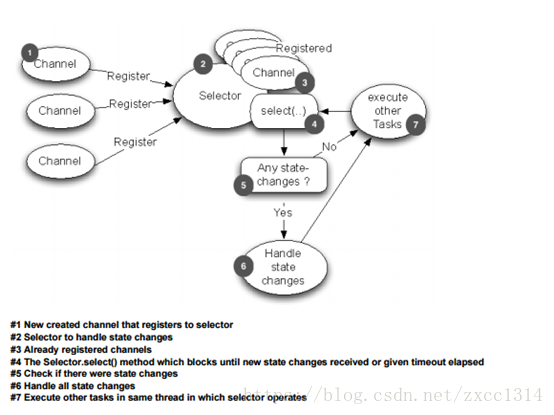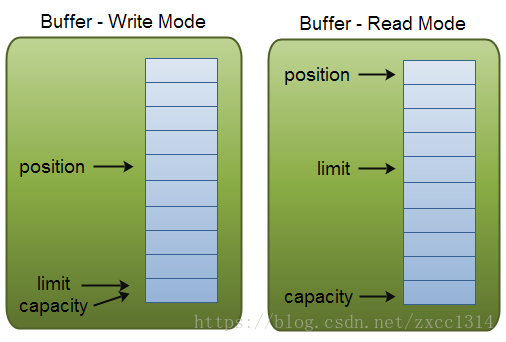Java 多线程NIO学习
- 阻塞IO 如果数据没有准备就绪,就一直等待,直到数据准备就绪;整个进程会被阻塞。
- 非阻塞IO 需不断询问内核是否已经准备好数据,非阻塞虽然不用等待但是一直占用CPU。
- 多路复用IO NIO 多路复用IO,会有一个线程不断地去轮询多个socket的状态,当socket有读写事件的时候才会调用IO读写操作。 用一个线程管理多个socket,是通过selector.select()查询每个通道是否有事件到达,如果没有事件到达,则会一直阻塞在那里,因此也会带来线程阻塞问题。
- 信号驱动IO模型 在信号驱动IO模型中,当用户发起一个IO请求操作时,会给对应的socket注册一个信号函数,线程会继续执行,当数据准备就绪的时候会给线程发送一个信号,线程接受到信号时,会在信号函数中进行IO操作。 非阻塞IO、多路复用IO、信号驱动IO都不会造成IO操作的第一步,查看数据是否准备就绪而带来的线程阻塞,但是在第二步,对数据进行拷贝都会使线程阻塞。
- 异步IO jdk7AIO 异步IO是最理想的IO模型,当线程发出一个IO请求操作时,接着就去做自己的事情了,内核去查看数据是否准备就绪和准备就绪后对数据的拷贝,拷贝完以后内核会给线程发送一个通知说整个IO操作已经完成了,数据可以直接使用了。 同步的IO操作在第二个阶段,对数据的拷贝阶段,都会造成线程的阻塞,异步IO则不会。
异步IO在IO操作的两个阶段,都不会使线程阻塞。 Java 的 I/O 依赖于操作系统的实现。
Java NIO的工作原理

- 由一个专门的线程(Selector)来处理所有的IO事件,并负责分发。
- 事件驱动机制:事件到的时候触发,而不是同步的去监视事件。
- 线程通讯:线程之间通过 wait,notify 等方式通讯。保证每次上下文切换都是有意义的。减少无谓的线程切换。
三大基本组件
Channel
- FileChannel, 从文件中读写数据。
- DatagramChannel,通过UDP读写网络中的数据。
- SocketChannel,通过TCP读写网络中的数据。
- ServerSocketChannel,可以监听新进来的TCP连接,对每一个新进来的连接都会创建一个SocketChannel。
Java NIO 的通道类似流,但又有些不同:
- 既可以从通道中读取数据,又可以写数据到通道。但流的读写通常是单向的。
- 通道可以异步地读写。
- 通道中的数据总是要先读到一个 Buffer,或者总是要从一个 Buffer 中写入。
Buffer
关键的Buffer实现 ByteBuffer,CharBuffer,DoubleBuffer,FloatBuffer,IntBuffer,LongBuffer,ShortBuffer
Buffer两种模式、三个属性:

capacity
作为一个内存块,Buffer有一个固定的大小值,也叫“capacity”.你只能往里写capacity个byte、long,char等类型。一旦Buffer满了,需要将其清空(通过读数据或者清除数据)才能继续写数据往里写数据。
position
当你写数据到Buffer中时,position表示当前的位置。初始的position值为0.当一个byte、long等数据写到Buffer后, position会向前移动到下一个可插入数据的Buffer单元。position最大可为capacity – 1. 当读取数据时,也是从某个特定位置读。当将Buffer从写模式切换到读模式,position会被重置为0. 当从Buffer的position处读取数据时,position向前移动到下一个可读的位置。
limit
在写模式下,Buffer的limit表示你最多能往Buffer里写多少数据。 写模式下,limit等于Buffer的capacity。 当切换Buffer到读模式时, limit表示你最多能读到多少数据。因此,当切换Buffer到读模式时,limit会被设置成写模式下的position值。换句话说,你能读到之前写入的所有数据(limit被设置成已写数据的数量,这个值在写模式下就是position)
参考链接:Buffer原理 www.cnblogs.com/chenpi/p/64…
Selector
Selector(选择器)是Java NIO中能够检测一到多个NIO通道,并能够知晓通道是否为诸如读写事件做好准备的组件。这样,一个单独的线程可以管理多个channel,从而管理多个网络连接。
监听四种事件
- SelectionKey.OP_CONNECT
- SelectionKey.OP_ACCEPT
- SelectionKey.OP_READ
- SelectionKey.OP_WRITE
select()方法
select()阻塞到至少有一个通道在你注册的事件上就绪了。 select(long timeout)和select()一样,除了最长会阻塞timeout毫秒(参数)。
selectedKeys()方法
调用selector的selectedKeys()方法,访问“已选择键集(selected key set)”中的就绪通道。
参考链接:操作系统层面分析Selector原理 zhhphappy.iteye.com/blog/203289…
NIO实现
服务端
public class NIOServerSocket {
//存储SelectionKey的队列
private static List<SelectionKey> writeQueue = new ArrayList<SelectionKey>();
private static Selector selector = null;
//添加SelectionKey到队列
public static void addWriteQueue(SelectionKey key){
synchronized (writeQueue) {
writeQueue.add(key);
//唤醒主线程
selector.wakeup();
}
}
public static void main(String[] args) throws IOException {
// 1.创建ServerSocketChannel
ServerSocketChannel serverSocketChannel = ServerSocketChannel.open();
// 2.绑定端口
serverSocketChannel.bind(new InetSocketAddress(60000));
// 3.设置为非阻塞
serverSocketChannel.configureBlocking(false);
// 4.创建通道选择器
selector = Selector.open();
/*
* 5.注册事件类型
*
* sel:通道选择器
* ops:事件类型 ==>SelectionKey:包装类,包含事件类型和通道本身。四个常量类型表示四种事件类型
* SelectionKey.OP_ACCEPT 获取报文 SelectionKey.OP_CONNECT 连接
* SelectionKey.OP_READ 读 SelectionKey.OP_WRITE 写
*/
serverSocketChannel.register(selector, SelectionKey.OP_ACCEPT);
while (true) {
System.out.println("服务器端:正在监听60000端口");
// 6.获取可用I/O通道,获得有多少可用的通道
int num = selector.select();
if (num > 0) { // 判断是否存在可用的通道
// 获得所有的keys
Set<SelectionKey> selectedKeys = selector.selectedKeys();
// 使用iterator遍历所有的keys
Iterator<SelectionKey> iterator = selectedKeys.iterator();
// 迭代遍历当前I/O通道
while (iterator.hasNext()) {
// 获得当前key
SelectionKey key = iterator.next();
// 调用iterator的remove()方法,并不是移除当前I/O通道,标识当前I/O通道已经处理。
iterator.remove();
// 判断事件类型,做对应的处理
if (key.isAcceptable()) {
ServerSocketChannel ssChannel = (ServerSocketChannel) key.channel();
SocketChannel socketChannel = ssChannel.accept();
System.out.println("处理请求:"+ socketChannel.getRemoteAddress());
// 获取客户端的数据
// 设置非阻塞状态
socketChannel.configureBlocking(false);
// 注册到selector(通道选择器)
socketChannel.register(selector, SelectionKey.OP_READ);
} else if (key.isReadable()) {
System.out.println("读事件");
//取消读事件的监控
key.cancel();
//调用读操作工具类
NIOHandler.read(key);
} else if (key.isWritable()) {
System.out.println("写事件");
//取消读事件的监控
key.cancel();
//调用写操作工具类
NIOHandler.write(key);
}
}
}else{
synchronized (writeQueue) {
while(writeQueue.size() > 0){
SelectionKey key = writeQueue.remove(0);
//注册写事件
SocketChannel channel = (SocketChannel) key.channel();
Object attachment = key.attachment();
channel.register(selector, SelectionKey.OP_WRITE,attachment);
}
}
}
}
}
}
复制代码
消息处理
public class NIOHandler {
//构造线程池
private static ExecutorService executorService = Executors.newFixedThreadPool(10);
public static void read(final SelectionKey key){
//获得线程并执行
executorService.submit(new Runnable() {
@Override
public void run() {
try {
SocketChannel readChannel = (SocketChannel) key.channel();
// I/O读数据操作
ByteBuffer buffer = ByteBuffer.allocate(1024);
ByteArrayOutputStream baos = new ByteArrayOutputStream();
int len = 0;
while (true) {
buffer.clear();
len = readChannel.read(buffer);
if (len == -1) break;
buffer.flip();
while (buffer.hasRemaining()) {
baos.write(buffer.get());
}
}
System.out.println("服务器端接收到的数据:"+ new String(baos.toByteArray()));
//将数据添加到key中
key.attach(baos);
//将注册写操作添加到队列中
NIOServerSocket.addWriteQueue(key);
} catch (IOException e) {
e.printStackTrace();
}
}
});
}
public static void write(final SelectionKey key) {
//拿到线程并执行
executorService.submit(new Runnable() {
@Override
public void run() {
try {
// 写操作
SocketChannel writeChannel = (SocketChannel) key.channel();
//拿到客户端传递的数据
ByteArrayOutputStream attachment = (ByteArrayOutputStream)key.attachment();
System.out.println("客户端发送来的数据:"+new String(attachment.toByteArray()));
ByteBuffer buffer = ByteBuffer.allocate(1024);
String message = "你好,我是服务器!!";
buffer.put(message.getBytes());
buffer.flip();
writeChannel.write(buffer);
writeChannel.close();
} catch (IOException e) {
e.printStackTrace();
}
}
});
}
}
复制代码
客户端
public class NIOClientSocket {
public static void main(String[] args) throws IOException {
//使用线程模拟用户 并发访问
for (int i = 0; i < 1; i++) {
new Thread(){
public void run() {
try {
//1.创建SocketChannel
SocketChannel socketChannel=SocketChannel.open();
//2.连接服务器
socketChannel.connect(new InetSocketAddress("localhost",60000));
//写数据
String msg="我是客户端"+Thread.currentThread().getId();
ByteBuffer buffer=ByteBuffer.allocate(1024);
buffer.put(msg.getBytes());
buffer.flip();
socketChannel.write(buffer);
socketChannel.shutdownOutput();
//读数据
ByteArrayOutputStream bos = new ByteArrayOutputStream();
int len = 0;
while (true) {
buffer.clear();
len = socketChannel.read(buffer);
if (len == -1)
break;
buffer.flip();
while (buffer.hasRemaining()) {
bos.write(buffer.get());
}
}
System.out.println("客户端收到:"+new String(bos.toByteArray()));
socketChannel.close();
} catch (IOException e) {
e.printStackTrace();
}
};
}.start();
}
}
}
复制代码
多线程NIO Tips
- 示例代码仅供学习参考。对于一个已经被监听到的事件,处理前先取消事件(SelectionKey .cancel())监控。否则selector.selectedKeys()会一直获取到该事件,但该方法比较粗暴,并且后续register会产生多个SelectionKey。推荐使用selectionKey.interestOps()改变感兴趣事件。
- Selector.select()和Channel.register()需同步。
- 当Channel设置为非阻塞(Channel.configureBlocking(false))时,SocketChannel.read 没读到数据也会返回,返回参数等于0。
- OP_WRITE事件,写缓冲区在绝大部分时候都是有空闲空间的,所以如果你注册了写事件,这会使得写事件一直处于就就绪,选择处理现场就会一直占用着CPU资源。参考下面的第二个链接。
- 粘包问题。
参考链接:SocketChannel.read blog.csdn.net/cao47820824…
参考链接:NIO坑 www.jianshu.com/p/1af407c04…
- 本文标签: id 多线程 Select src tab executor cat UDP synchronized 参数 线程池 https 服务端 管理 遍历 tag client 服务器 ioc 进程 TCP ArrayList REST IOS ip 工作原理 IDE App 并发 同步 java Service 线程 做自己 代码 list ACE remote IO 数据 CTO stream final rmi queue tar 模型 SDN key http 端口 NIO UI 空间 AIO 操作系统 message
- 版权声明: 本文为互联网转载文章,出处已在文章中说明(部分除外)。如果侵权,请联系本站长删除,谢谢。
- 本文海报: 生成海报一 生成海报二










![[HBLOG]公众号](https://www.liuhaihua.cn/img/qrcode_gzh.jpg)

